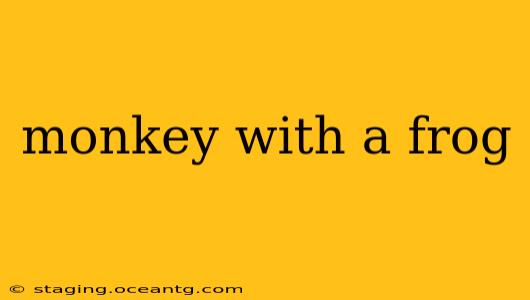The Curious Case of Monkeys and Frogs: An Unexpected Relationship
The image of a monkey and a frog together might conjure whimsical scenes, perhaps from a children's book or a fantastical animation. While unlikely companions in the wild, the relationship between monkeys and frogs is far more complex and intriguing than a simple juxtaposition. This article delves into the various ways these seemingly disparate creatures interact, exploring their ecological connections and the fascinating dynamics that arise from their encounters.
What do monkeys eat that includes frogs?
While not a staple diet for most monkey species, some primates do consume frogs as part of their opportunistic omnivorous diet. Certain monkeys inhabiting rainforest environments, where frogs are readily available, might occasionally include them in their meals. The exact species of monkey and frog involved varies depending on the location and specific environmental factors. It's important to note that frogs generally don't make up a significant portion of a monkey's diet; it's more of an occasional supplementary food source.
Do monkeys play with frogs?
Direct evidence of monkeys "playing" with frogs in the sense of human-defined play is limited. However, there are accounts of monkeys interacting with frogs in ways that could be interpreted as playful. Young monkeys, particularly, might exhibit exploratory behavior, touching or manipulating a frog out of curiosity rather than malice. It's crucial to remember that what constitutes "play" can differ greatly across species, and anthropomorphizing animal behavior can be misleading. Further research is needed to definitively understand the nature of these interactions.
Are monkeys predators of frogs?
Some monkey species can be considered opportunistic predators of frogs, especially smaller species. Again, this isn't their primary food source but rather a supplementary food item when opportunities arise. The act of predation, if it occurs, would typically involve catching and consuming the frog. The size and type of frog, as well as the size and species of the monkey, are all factors that influence whether a predatory interaction is likely.
Do monkeys and frogs live in the same habitat?
Yes, monkeys and frogs frequently share habitats, particularly in tropical rainforest ecosystems. Their overlapping ranges create opportunities for both indirect and direct interactions. These interactions can include competition for resources (like insects) or predator-prey relationships, as discussed previously. The specific species of monkeys and frogs present will, of course, determine the nature and frequency of their interactions within a given habitat.
What are the symbiotic relationships between monkeys and frogs?
The relationship between monkeys and frogs isn't typically described as strongly symbiotic in a classic mutually beneficial way (like a cleaner fish and a larger fish). However, indirect interactions are plentiful. For instance, frogs may serve as a food source for larger predators that also prey on monkeys, indirectly impacting the monkey population. Conversely, monkeys may unintentionally disperse frog eggs or tadpoles by moving through the environment. These indirect influences create a complex ecological web where their presence influences each other’s populations and survival.
Conclusion:
The relationship between monkeys and frogs isn't a straightforward one, instead forming a fascinating chapter in the broader context of rainforest ecology. While not typically depicted as close companions, their interactions, though varied, are integral to the intricate balance of life within their shared environments. Further research is needed to fully uncover the nuances of their encounters, particularly regarding the subtleties of their interactions and the influence of these interactions on population dynamics.
